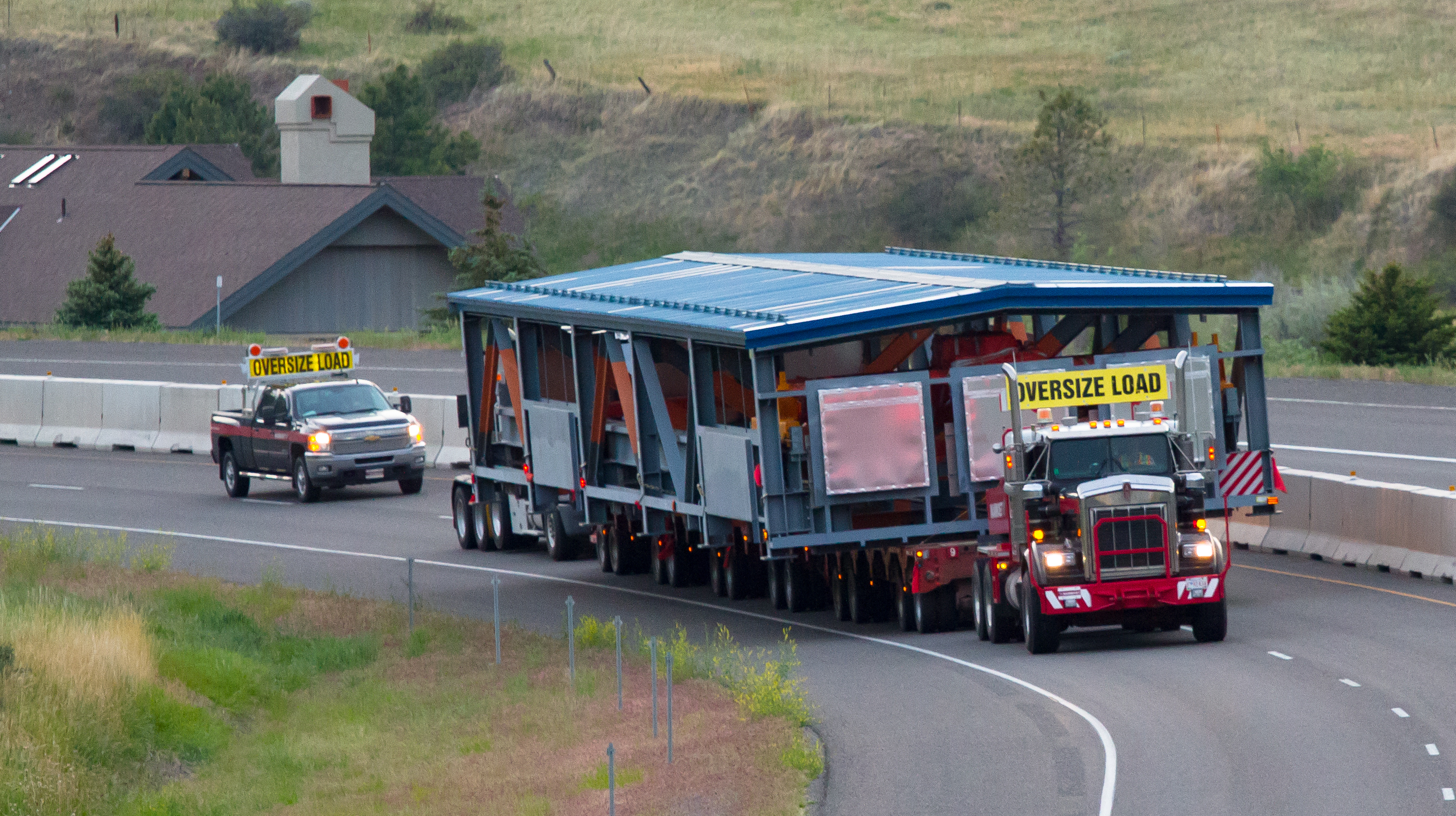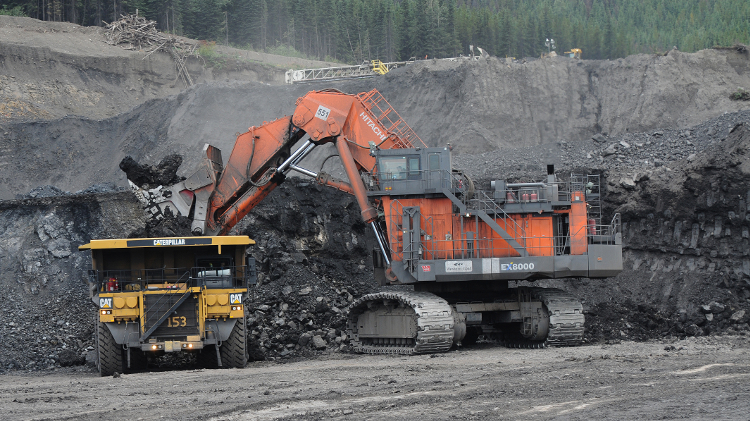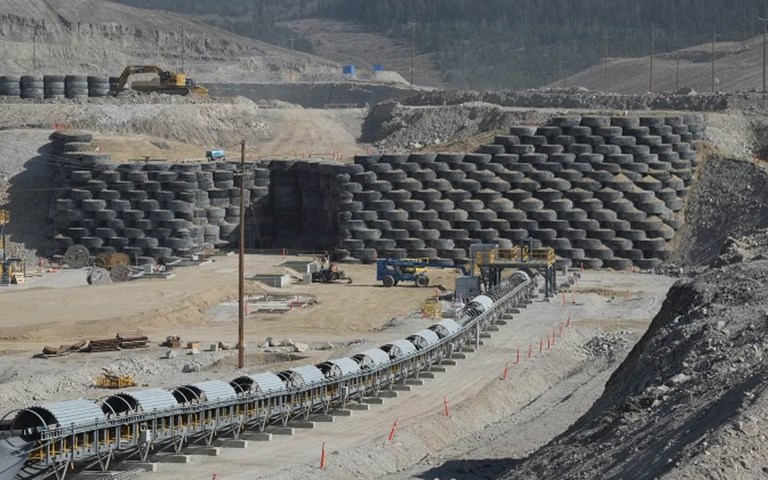Teck Resources reused off-the-road tires to create a mechanically stabilized earth wall at its Highland Valley Copper mine. Courtesy of Teck Resources
At any one time, there are 300 haul truck tires rolling through Teck Resources’ Highland Valley Copper mine in southern British Columbia, fitted to the operation’s 50-strong fleet of Caterpillar 793 haul trucks.
With a wear life of roughly 12 months, that means 300 orphaned tires per year. And while some are repurposed to create berms (raised barriers beside a haulage road or dump point) or to protect mine infrastructure, Highland Valley Copper’s senior geotechnical engineer, Mathieu Veillette, said that historically the tires are “mostly stockpiled.”
Tire stockpiling is common on mine sites, given that the cost of recycling haul truck tires, which weigh over 3,500 kilograms each, is steep. Tire Business magazine reported in 2010 that large off-the-road scrap tires cost between US$100 and US$200 to recycle, not counting shipping costs.
These are all reasons why, when Teck needed to build a new mechanically stabilized earth (MSE) wall for the mine in late 2014, it decided to construct it using old haul truck tires. The 16-metre-high wall would require 600 tires to be used for both the wall’s face and its anchoring components, buried in the wall backfill.
At the time, Teck was extending the Highland Valley Copper open pit in order to reach 30 million tonnes of newly categorized Mineral Reserves. As a result, one of the mine’s existing crushers needed to be moved closer to the new ore body so that haul trucks did not waste time, fuel and money ferrying ore long distances. The new MSE wall surrounds the crusher in its new location on three sides, tightly clamping back the surrounding earth. It also provides a much-needed ledge from which haul trucks can dump material into the crusher from above.
MSE walls, a common fixture in open and underground mines as well as bridges and highway construction, are traditionally produced by specialist companies and made from custom-made geosynthetic, metal or concrete facing elements attached to layers of metal strips, mesh and geogrid nestled in the wall backfill.
“It’s cheaper and more sustainable to reuse worn tires than to buy all these new products and hire a vendor to create this wall,” explained Veillette.
Teck spokesperson Chris Stannell said that the savings from constructing the wall using tires versus a standard MSE wall was “in the range of 25 to 50 per cent, along with the environmental benefits associated with reusing haul truck tires,” although he noted that a number of factors are variable to each project, including materials and engineering. Teck could not provide an overall cost for the project.
Dusting off an old idea
The inspiration behind using old haul truck tires came from an existing tire wall at Highland Valley Copper that had been built in 2005. The pencil drawings and other key design and construction files of the existing wall had not been well documented, however, so Teck turned to BGC Engineering to construct and design the new wall. The firm was already employed in other elements of the crusher move.
There was one key difference between the old tire wall and the new wall: the new wall’s face would include a vertical portion around the pocket where the crusher’s steel hopper would be inserted. The rest of the new wall’s face, like its predecessor, would have a battered, or receding, slope.
Related: Teck’s digital architect, Kalev Ruberg, is shaping a digital transformation
BGC was happy to take on the project. “We asked around and it seemed like no one else had designed [MSE walls out of used haul truck tires], or if they had, it hasn’t been documented,” said Eric Coffin, one of BGC’s project engineers on the wall’s construction, who presented the work for the first time at the CIM Convention in May in Vancouver. “So we wanted to write a paper on it and get it out there and let people know what we are doing. It’s a good way to reuse these tires.”
Making a wall out of wheels
The first step of the process for BGC was a full-scale pull test in April 2014, constructed about five kilometres northwest of Highland Valley Copper’s mill. Two Caterpillar 793 tires, which have a 3.5-metre diameter and are 1.1-metres-wide, were wrapped in steel cables of different sizes and buried in a stockpile of the area’s naturally occurring sand. The same sand would be used for the wall’s backfill, another practical, affordable and sustainable choice.
“The tire is an unknown object in the whole design,” explained Coffin. “We needed to test the strength of that rubber.” Using an engineered “loading apparatus” comprised of steel beams, steel thread bars, monitoring instruments, a hydraulic jack and concrete blocks, the team applied different forces on the cables in order to see whether they would rip or dislodge the tires.
In the end, the pull test revealed that the tires could withstand at least 540 kilonewtons (about 121,000 pounds) of tension without ripping or moving. (This is a conservative upper limit, given that a separate calculation on an inflated and unburied haul truck tire indicated that it could endure over double that force.) This pull test informed the final design of the wall; BGC could rest assured that connections between the haul truck tires and the 22-millimetre-diameter cables could easily resist the calculated load for the final wall.
Construction on the wall began in September 2014. Used tires were delivered to the site by flatbed trunk and hoisted and moved using an excavator thumb apparatus. Front-facing tires were attached to anchor tires by seven-metre-long steel cables, which were tightened around the tires using Crosby clamps and pulled tight using an excavator bucket. Sand was carefully and densely compacted inside and between the tires as well as between the anchor tires and the existing slope.
Related: Teck launches autonomous haul truck pilot at Highland Valley Copper
In mid-October, when the wall was 12 rows high and 75 per cent complete, operations were suspended for the winter months. Then BGC encountered a design challenge. The front tires at the top of the vertical section of the wall were leaning into the crusher hopper pocket. Coffin said he suspected the lean was because “the sand wasn’t fully compacted inside the front of those tires.”
“It was only a couple centimetres, but it was leaning, so we put a halt to construction and came together to think about the best way forward,” he said. The team decided to move the crusher in before raising the wall to its final height.
On May 5 the crusher was lugged on a self-propelled trailer to its new home in the wall’s pocket. This resolved the inward deflection problem and mitigated any safety concerns, said Coffin, because, as anticipated, the “crusher supported the lean.” The gap between the hopper structure and the vertical wall was then filled with gravel. The final layers of the battered section of the wall were laid and the concrete apron was installed at the top.
The tire wall was completed on schedule on May 22, 2015; it is expected to last until production at Highland Valley Copper ends in 2028.
Veillette said Teck “liked the results” – and joked that “we haven’t heard anything more about it, so we know it’s working well.” He said Teck would gladly consider using tires for future MSE walls at the mine. “Overall, we’re just glad we can use those tires for something sustainable and useful,” he said.
Coffin said he thinks other mines will follow suit, too, if they need a wall and have a surplus of tires. “It’s innovative and seems fairly simple to construct compared to a concrete MSE wall.”




